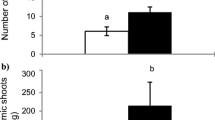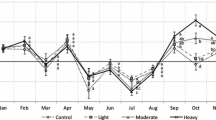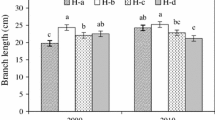Abstract
Key message
More vigorous watersprouts and fewer low vigor shoots form as wood age increases at the cutting points with greater canopy pruning depth in olive trees, which reduces return flowering. Such information is relevant to long-term olive orchard pruning strategies in hedgerows.
Abstract
Demographic analysis of growth responses to pruning in fruit trees seeks the quantification of the typology of new shoots originating from the remaining branches. Pruning of hedgerows using mechanical discs is becoming increasingly common in orchards, but little information is available as to how such pruning, which does not discriminate between branch size, wood age at the cutting point, branch type, or position, modifies subsequent new shoot demography. Hence, the experiment described in this study in young olive trees (cv. Arbequina) assessed the following questions: (1) Is the type and growth of new shoots associated with the intensity of mechanical pruning and/or the wood age on which they grow? (2) How many growing seasons does it take for new shoots formed after pruning to flower? The principal hypothesis was that a greater proportion of vigorous watersprouts form compared to low vigor shoots as wood age at the cutting points increases with canopy pruning depth, and that the watersprouts have low flowering potential. Both new shoot growth and return flowering were monitored on exposed supporting wood over several growing seasons after implementing three winter (25W, 50W, and 75W) pruning levels of increasing intensity and one summer pruning (75S) treatment along with an unpruned control (CON). As hypothesized, a greater number and elongation of vigorous watersprouts were found as wood age increased at the cutting points with greater winter pruning intensity, and the watersprouts had low levels of return flowering even 3 full years after pruning compared to the CON. Growth of low vigor shoots was relatively more important than watersprout growth in the severe summer pruning treatment, although 3 years after the summer pruning flowering was not fully recovered. In contrast, the more lightly pruned winter treatments (25W, 50W) did not show significant differences in flowering with the CON at the end of 3 years. Thus, mechanical hedge pruning in olive trees should be light-to-moderate to avoid the formation of watersprouts on older wood, which leads to long-term reductions in flowering.




Similar content being viewed by others
References
Albarracín V, Hall AJ, Searles PS, Rousseaux MC (2017) Responses of vegetative growth and fruit yield to winter and summer mechanical pruning in olive trees. Sci Hortic 225:185–194
Bangerth KF (2009) Floral induction in mature, perennial angiosperm fruit trees: similarities and discrepancies with annual/biennial plants and the involvement of plant hormones. Sci Hortic 122:153–163
Bevacqua D, Genard M, Lescourret F (2012) A simple model to predict the probability of a peach (Prunus persicae) tree bud to develop as a long or short shoot as a consequence of winter pruning intensity and previous year growth. PloS One 7:1–6
Bussi C, Bruchou C, Lescourret F (2011) Response of watersprout growth to fruit load and intensity of dormant pruning in peach tree. Sci Hortic 130:725–731
Bussi C, Genard M, Horticoles S, Avignon F (2014) Thinning and pruning to overcome alternate bearing in peach trees. Eur J Hortic Sci 79:313–317
Castillo-Llanque FJ, Rapoport HF (2011) Relationship between reproductive behavior and new shoot development in 5-year-old branches of olive trees (Olea europaea L.). Trees 25:823–832
Connor DJ, Fereres E (2005) The physiology of adaptation and yield expression in olive. Hortic Rev 31:155–229
Connor DJ, Gómez-del-Campo M, Rousseaux MC, Searles PS (2014) Structure, management and productivity of hedgerow olive orchards: a review. Sci Hortic 169:71–93
Costes E, Sinoquet H, Kelne JJ, Godin C (2003) Exploring within-tree architectural development of two apple tree culitivars over 6 years. Ann Bot 99:91–104
Dag A, Bustan A, Avni A, Tzipori I, Lavee S, Riov J (2010) Timing of fruit removal affects concurrent vegetative growth and subsequent return bloom and yield in olive (Olea europaea L.). Sci Hortic 123:469–472
Dalkiliç GG, Dalkiliç Z, Mestav HO (2014) Effect of different pruning severity on vegetative growth in peach (Prunus persica). Türk Tarım ve Doğa. Bilimleri 7:1505–1508
De Melo-Abreu JP, Barranco D, Cordeiro AM, Tous J, Rogado BM, Villalobos FJ (2004) Modelling olive flowering date using chilling for dormancy release and thermal time. Agric For Meteorol 125:117–127
Di Rienzo JA, Casanoves F, Balzarini MG, Gonzalez L, Tablada M, Robledo CW (2014) InfoStat versión 2014. Grupo InfoStat. FCA, Universidad Nacional de Córdoba, Argentina. http://www.infostat.com.ar. Accessed 15 Dec 2017
Elliott RC, Ross JJ, Smith JJ, Lester DR, Reid JB (2001) Feed-forward regulation of gibberellin deactivation in pea. J Plant Growth Regul 20:87–94
Fereres E, Pruitt WO, Beutel JA, Henderson DW, Holzapfel E, Shulbach H, Uriu K (1981) ET and drip irrigation scheduling. In: Fereres E (ed) Drip irrigation management. University of California Division of Agriculture Science, Tulelake, pp. 8–13
Fernández FJ, Ladux JL, Searles PS (2015) Dynamics of shoot and fruit growth following fruit thinning in olive trees: same season and subsequent season responses. Sci Hortic 192:320–330
Fiorino P, Marone E (2010) The fate of lateral buds in the olive (Olea europaea L. ssp. europaea var. europaea). A first report. Adv Hortic Sci 24:29–34
Fumey D, Lauri P, Guédon Y, Godin C, Costes E (2011) How young trees cope with removal of whole or parts of shoots: an analysis of local and distant responses to pruning in 1-year-old apple (Malus × domestica; Rosaceae) trees. Am J Bot 98:1737–1751
Gucci R, Cantini C (2000) Pruning and training systems for modern olive growing. CSIRO, Collingwood
Haberman A, Ackerman M, Crane O, Kelner JJ, Costes E, Samach A (2016) Different flowering response to various fruit loads in apple cultivars correlates with degree of transcript reaccumulation of a TFL1-encoding gene. Plant J 87:161–173
Haberman A, Bakhshian O, Cerezo-Medina S, Paltiel J, Adler C, Ben-Ari G, Mercado J (2017) A possible role for flowering locus T-encoding genes in interpreting environmental and internal cues affecting olive (Olea europaea L.) flower induction. Plant Cell Environ 7:1–18
Hackett WP, Hartmann HT (1964) Inflorescence formation in olive as influenced by low temperature, photoperiod, and leaf area. Bot Gaz 125:65–72
Harper JL, White J (1974) The demography of plants. Ann Rev Ecol Syst 5:419–463
Lauri PE, Terouanne E, Lespinasse JM (1996) Quantitative analysis of relationships between inflorescence size, bearing-axis size and fruit-set—an apple tree case study. Ann Bot 77:277–286
Lavee S (2007) Biennial bearing in olive (Olea europaea L.). Annales Ser His Nat 17:101–112
Li KT, Lakso AN (2004) Photosynthetic characteristics of apple spur leaves after summer pruning to improve exposure to light. HortSci 39:969–972
Li KT, Lakso AN, Piccioni R, Robinson T (2003) Summer pruning reduces whole-canopy carbon fixation and transpiration in apple trees. J Hortic Sci Biotech 78:749–754
Lopez-Bernal A, Villalobos FJ, Garcıa-Tejera O, Testi L, Orgaz F (2017) Do olive vegetative buds undergo a real dormant state in winter ? Acta Hortic 1060:227–230
Mohammadi A, Mahmoudi MJ, Rezaee R (2013) Vegetative and reproductive responses of some apple cultivars (Malus domestica Borkh.) to heading back pruning. Int J AgriSci 3:628–635
Normand F, Bello AKP, Trottier C, Lauri P (2009) Is axis position within tree architecture a determinant of axis morphology, branching, flowering and fruiting? An essay in mango. Ann Bot 103:1325–1336
Rousseaux MC, Figuerola PI, Correa-Tedesco G, Searles PS (2009) Seasonal variations in sap flow and soil evaporation in an olive (Olea europaea L.) grove under two irrigation regimes in an arid region of Argentina. Agric Water Manag 96:1037–1044
Sanz-Cortés F, Martínez-Calvo J, Badenes ML, Bleiholder H, Hack H, Llácer G, Meier U (2002) Phenological growth stages of olive trees (Olea europaea). Ann Appl Biol 140:151–157
Stanley J (2016) Factors affecting fruit set and fruit quality along branch units of different apricot cultivars. N Zeal J Crop Hortic 44:171–191
Stephan J, Lauri PE, Dones N, Haddad N, Talhouk S, Sinoquet H (2007) Architecture of the pruned tree: impact of contrasted pruning procedures over 2 years on shoot demography and spatial distribution of leaf area in apple (Malus domestica). Ann Bot 99:1055–1065
Tiyayon C, Strik B (2010) Effect of fruiting cane origin on fruitfulness of hardy kiwifruit, Actinidia arguta. New Zeal J Crop Hortic 31:179–186
Tombesi S, Molfese M, Cipolletti M, Visco T, Farinelli D (2014) Pruning technique in young high density hedgerow olive orchards. Acta Hortic 1057:385–390
Trentacoste ER, Puertas CM, Sadras VO (2010) Effect of fruit load on oil yield components and dynamics of fruit growth and oil accumulation in olive (Olea europaea L.). Eur J Agron 32:249–254
Vázquez-Valdivia V, Pérez-Barraza MH, Osuna-García JA, Urías-López MA (2009) Intensidad de poda sobre el vigor, producción y peso del fruto, del mango ‘Ataulfo’. Revista Chapingo Serie Horticultura 15:127–132
Vivaldi GA, Strippoli G, Pascuzzi S, Stellacci AM, Camposeo S (2015) Olive genotypes cultivated in an adult high-density orchard respond differently to canopy restraining by mechanical and manual pruning. Sci Hortic 192:391–399
Acknowledgements
We thank Emilio Caimi of Olivos Argentinos S.A. for access to their commercial orchard. Eduardo Barbero and Andrés Herrera provided technical support in the field. This research was supported by grants from the Ministerio de Ciencia, Técnica e Innovación Productiva de Argentina (ANPCyT, PICT2012 0178) and CONICET (PIP2012 11220110100545). VA held a doctoral scholarship from CONICET. MCR, AJH, and PSS are members of CONICET.
Author information
Authors and Affiliations
Corresponding author
Ethics declarations
Conflict of interest
The authors declare that they have no conflict of interest.
Additional information
Communicated by Grote.
Rights and permissions
About this article
Cite this article
Albarracín, V., Hall, A.J., Searles, P.S. et al. Impact of simulated mechanical hedge pruning and wood age on new shoot demography and return flowering in olive trees. Trees 32, 1767–1777 (2018). https://doi.org/10.1007/s00468-018-1749-1
Received:
Accepted:
Published:
Issue Date:
DOI: https://doi.org/10.1007/s00468-018-1749-1




